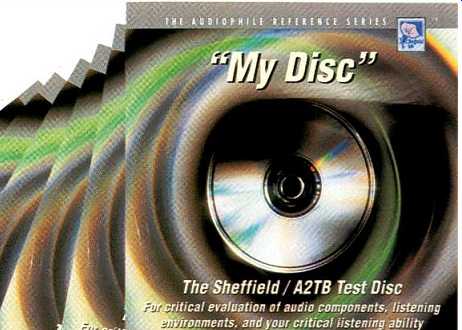
by EDWARD M. LONG
Sheffield/A2TB Test Disc
Company Address: do Sheffield Lab, 1046 Washington St., Raleigh, N.C. 27605.
Avery useful addition to your CD library, My Disc is the result of a collaboration be tween audio consultants Richard Clark and David Navone, publishers of Autosound 2000 Tech Briefs, and Oscar Ciornei and Doug Sax of Sheffield Lab Recordings. My Disc not only has musical selections (on the first six tracks) but also has 80 tracks with test signals and auditory tests. Many of these tests cannot be found on other CDs. For example, after tracks 7 and 8, which have very accurate signal levels at-20 and 0 dB, respectively, tracks 9 through 18 have octave-wide warble tones that are very useful for deter mining the response of loudspeaker systems and earphones. The center frequencies of the warble tones are 20, 62, 125, 250, and 500 Hz, and 2.5, 5, 10, 15, and 19 kHz. (The limitation of the CD format does not allow for signals above 20 kHz.) Each tone in the series is 3 seconds long, preceded by a 1-kHz reference tone for comparison. The loudness of each of the tones should be the same as that of the reference tone if the frequency response of your system is uniform. The "warbling" of the tones, from 20 Hz to 19 kHz, helps to prevent the buildup of standing waves in a room, especially in the lower frequency range.
I really appreciate the thought that went into making track 19, where you'll hear a voice counting from 1 to 25. Although it may appear simple, it was recorded with a Bruel & Kjaer instrumentation microphone that makes the voice extremely natural, with no colorations or "enhancement." This track can help you assess colorations caused by your listening room's reflections and standing waves; if you use it to help you decide which new loudspeaker system to buy, it will quickly sort out the choices.
Tracks 20 and 21 are for identifying right and left channels. Track 22 is a voice check for left- versus right-channel polarity. Track 23 is a series of four pulses; the first three are positive, and the fourth is negative. This track has appeared before, as track 10 on The Sheffield/Coustic Setup and Test CD (10040-2-T), a disc primarily for car audio and home theater systems. I have used this track to determine, by listening, the correct absolute polarity of the acoustic output of earphones and speaker systems.
Because the test signals on track 23 are hard to capture on anything but a digital oscilloscope, track 24 has a continuous sine wave, with its negative side clipped, to allow a technician to see the proper polarity on an analog 'scope.
Tracks 25 and 26 feature three people talking, first individually and then all at once. These tracks help determine the accuracy of image placement by speaker systems-and your ability to use your speakers to resolve complex sounds binaurally.
Tracks 27 to 32 will help determine how well speaker systems and room acoustics are working together with regard to image placement and coloration. You will quickly hear differences with this test, allowing you to make adjustments in speaker placement to minimize these differences.
Tracks 33 to 40 contain a 45-second musical excerpt, recorded from 0 dB on track 33 to -70 dB on track 40. Track 41 is total silence. Track 42 is a high-frequency signal for use with test instruments.
Tracks 43 and 44 have, respectively, correlated and uncorrelated pink noise. Track 45 has pink noise raised in 1-dB steps every 3 seconds; track 46 uses 3-dB steps. Tracks 47 to 56 have third-octave filtered pink noise from 31.5 Hz to 16 kHz. You could use a Radio Shack sound-level meter to check the frequency response of your system at different room locations.
Tracks 57 to 59 have continuous and warble tones for checking response and resonances. Tracks 60 to 62 contain sweeps, for use with instruments. Track 63 has the musical note A4 (440 Hz), to check speed accuracy of a CD player. Tracks 64, 65, and 66 have 100 Hz, 1-kHz, and 10-kHz tone bursts. Tracks 67 and 68 feature 100- and 1,000-Hz square waves. The purpose of tracks 69 and 70 is to show the effects of dynamic compression.
Tracks 71 to 76 demonstrate the sound of distortion added to a test signal in con trolled amounts, allowing you to explore your own listening capabilities. Tracks 77 to 82 are intended to show the same thing, this time with a musical excerpt. These tracks prove that it is easier to hear distortion when you listen at moderate levels, where your auditory system is not overloaded.
Tracks 83 and 84 are intended to demonstrate the effects of low-frequency time de lay on the quality of reproduced sound. A low-pass filter causes the sound below 100 Hz to be delayed by about 7 mS without affecting the signal's overall frequency response. (It would be interesting to have a test signal with the range below, say, 2 kHz delayed by 1 or 2 mS.) Tracks 85 and 86 were recorded at the Indianapolis Motor Speedway with "In The Ear" (ITE) microphones that were developed by Mead Killion of Etymotic Research.
These tracks are best heard over earphones (ideally the Etymotic ER-4 "In The Ear" model). The accuracy of the spatial information is uncanny when you refer to the notes that accompany My Disc. This experience alone might be worth the $29.95 cost of this CD.
My Disc should be in the collection of every serious audiophile.
(Audio magazine, Nov. 1995)
Also see:
Telarc OmniDisc Test Record (Feb. 1983)
= = = =